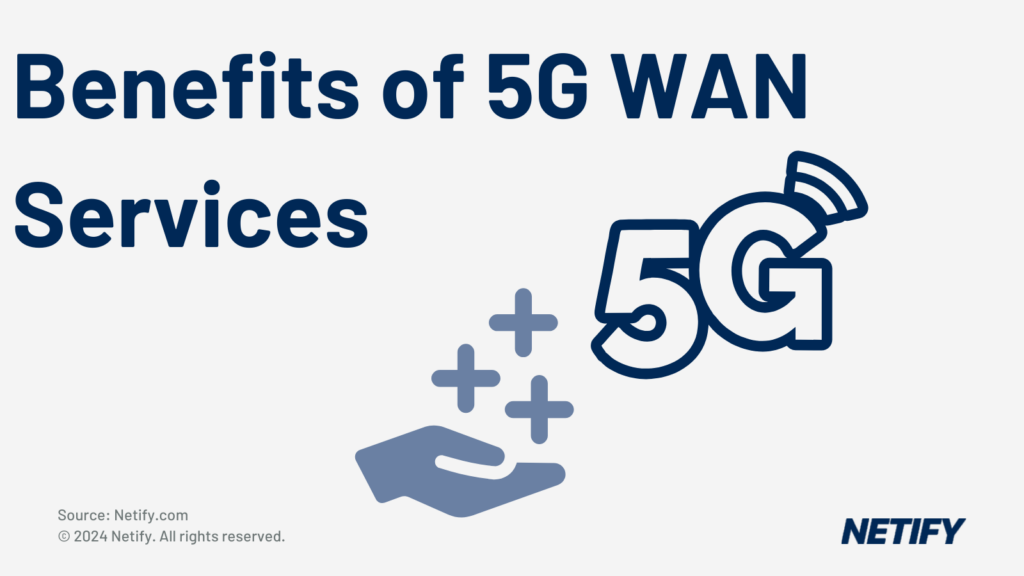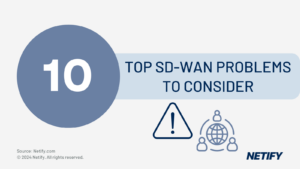| 5G WAN services offer faster connectivity, improved signal quality and enables mobiles & remote workforces. |

There is a lot of hype surrounding the 5G wireless standards and the anticipated new possibilities they will bring to global connectivity. And, there is little doubt that 5G enabled devices will have a positive impact on business operations, particularly in the Wide Area Network (WAN), though you must be careful to separate marketing hype from reality. In particular, the rollout of 5G among all the major telecommunications carriers is expected to bring a large increase of bandwidth, but you still cannot ignore the fundamental properties of wireless communications, such as ensuring good signal strength for your 5G devices.
Table of Contents
What are the topics surrounding 5G for WAN connectivity?
1. 4G LTE history and limitations.
2. 5G development.
3. 5G Impact to business.
4. Planning for 5G in the WAN.
5. New business opportunities.
6. Looking to the future.
Your business might be currently considering a new SD WAN deployment and wondering if you should wait for 5G to be deployed before pursing that route. You may currently have 4G/LTE devices as part of your WAN infrastructure and wish to understand how 5G will change things. The rollout of 5G over the next few years may indeed be a catalyst for new business opportunities depending on your situation and business needs. Understanding what options 5G WAN services bring to businesses along with their limitations is important for designing a solid WAN that incorporates 5G connectivity.
4G LTE history and limitations
As a deployed standard, 4G has been with us for nearly 10 years as of this writing. The International Telecommunications Union (ITU) is responsible for setting the worldwide standards and goals which specify minimum requirements for technologies like 4G and 5G, under the Radio communication sector (ITU-R) with International Mobile Telecommunications (IMT) standards. For instance, the IMT-2000 standard specified the minimum requirements a technology must meet in order to be marketed as 3G. Later, IMT-Advanced specified 4G, and IMT-2020 specifies 5G. The ITU creates the standards, and then other organisations like the Institute of Electrical and Electronics Engineers (IEEE) and 3rd Generation Partnership Project (3GPP) develop and implement the underlying technologies to meet or exceed the ITU-defined standards.
4G improved upon the older 3G standards by requiring the 4G carrier infrastructure to be based entirely on an IP packet-switched network. Former 3G networks incorporated IP packet-switching for some of the data functions, but still relied on traditional circuit-switched telephony technologies for voice and SMS communications. The move from 3G to 4G radically improved the available bandwidth for connected devices, which opened new opportunities to use wireless technologies in the WAN.
The 4G standard specifies up to 1 Gbps of downstream data for a non-moving device, such as an LTE modem that you might use for a WAN connection. Like most technologies, this is where hype meets reality. That theoretical 1 Gbps is for both ideal wireless conditions, as well as for just a single device connected to a cell tower: a practical impossibility.
The operational reality of using 4G in the WAN is that the performance depends on many different variables, including wireless conditions, the number of devices sharing the single cell tower, along with your application’s bandwidth and latency requirements. For example, your 4G WAN connection may support 20 simultaneous users if their bandwidth requirements are low, and latency isn’t a major concern, such as with light transactional data like general web browsing. However, those same 20 users will be unlikely to have a decent experience with real-time video-based teleconferencing over that same 4G connection.
Your business might exist in a very poor service area with a very weak wireless signal. Even if you utilise stronger carefully-placed external antennas, the service you receive may still be unusable for a WAN connection for anything other than a “best effort, better than nothing” connection. You might not be able to make a VoIP call, but you might still be able to check your email in this kind of situation.
5G development
As we have seen in the past, telecommunications carriers are quick to build anticipation for upcoming technologies even before the standards have been implemented. As this is being written, some carriers are already claiming “pre-5G” availability based on various improvements to the existing 4G standards, even though what they are marketing is not technically 5G according to the IMT-2020 standards. This causes confusion in the market and conflates what may be possible for the future as the standards are actually implemented over time, though in the carriers’ defence, they must make a significant investment in the technologies to power the infrastructure before they can see a return from subscribers over time.
In the same way that 4G was a revolutionary jump in speed and capabilities from 3G, 5G is expected to do the same for 4G. For example, while 4G has a theoretical downstream capacity of 1 Gbps, 5G is expected to provide a minimum of 20 Gbps. Once again, that is shared across all subscribers connected to the same cell tower, but 5G will also include technologies that make sharing of the bandwidth more efficient, which leads to greater overall throughput and a better user experience for everyone.
One of the interesting aspects of 5G is that it is not being developed with just an increase in speed as the primary motivation. 5G will support many different technologies to support multiple types of communications. As devices continue to get smaller and more portable, 5G will cater to the Internet of Things (IoT) market where many tiny low-powered sensors and other devices will benefit from wireless communications across large distances. Most IoT devices do not require a lot of bandwidth but may need to communicate across great distances. Likewise, 5G seeks to improve dramatically on latency and the ability to communicate with devices in motion at higher speeds, such as inside vehicles and high-speed trains, with usable connectivity up to 500 km/h.
Impact to business
5G is going to bring new opportunities for nearly all businesses that require communications over a large distance. Like all technologies, though, you must look beyond the marketing to realise where the true value will be to your business. For instance, while 5G does promise speeds that are far superior to 4G, those speeds are only attainable using higher frequencies. Higher frequencies enable faster speeds, but the trade-off is that higher frequencies do not propagate as well as lower frequencies and are much more susceptible to interference, such as from walls and windows in a building, along with foliage outside. From a business standpoint, this means you might need to invest in specialised directional antennas along with professional installation in order to achieve the best performance when using 5G as part of your WAN, though the same is true with 4G as well.
At the same time, 5G will offer improvements in wireless reception in the lower frequencies. This includes techniques like more advanced Quadrature Amplitude Modulation (QAM) levels which encode more bits with each transmission cycle, along with improved Multiple Input Multiple Output (MIMO) antenna array capabilities. 2×2 MIMO is common in 4G networks, and some carriers even support 4×4 MIMO in certain markets. 5G will support more simultaneous antenna usage with 16×16 having been demonstrated already, up to a theoretical 64×64. When a single device uses multiple antennas, signal quality can be improved through techniques like beamforming where the wireless transmission is coordinated between the sender and receiver to minimise interference.
The combined improvements in wireless transmission and reception mean your 5G devices are much more likely to receive a higher quality signal in more locations than were previously possible with 4G. As mentioned, this might not improve theoretical speeds as compared to 4G when lower frequencies are used, but another way to look at it is that a 5G device in the same location as a 4G device is much more likely to have an improved Quality of Experience (QoE) simply due to improved reception. This ultimately leads to better performance within the same environment, which leads to greater business opportunities to use 5G for WAN connectivity. A 5G WAN device might be perfectly acceptable in the same location where a 4G WAN device is barely usable.
Planning for 5G in the WAN
At the beginning of 2019, many businesses use 4G/LTE as part of their WAN strategy. Most use it for backup connectivity for smaller branch offices if their primary circuit goes offline. Very small offices may also use it as their primary WAN connectivity. Using wireless technology as part of the WAN infrastructure is increasing in popularity with the proliferation of SD WAN platforms. With SD WAN, you can easily incorporate wireless WAN as either a backup or standby connection, or even use it alongside a primary wired connection for improved resiliency. SD WAN even makes it possible to easily use multiple wireless connections using different carriers.
Just like with the upgrade from 3G to 4G, the upgrade to 5G will require new devices in order to use the service. This will likely be a major consideration for your business if you are currently or planning to use wireless services in your WAN. At a minimum, using 5G services requires a new radio chipset or modem. Some devices allow you to upgrade simply by switching out the modem for one that is capable of using 5G. For devices with the modem directly integrated into the product, you will need to completely replace the device in order to use 5G.
When taking technologies like SD WAN into consideration, it is more common for SD WAN appliances to use wireless as an external connectivity option, rather than be integrated. For example, the wireless could be provided by a USB device, or from a standalone device with a standard Ethernet handoff. In both of these scenarios, your SD WAN can be upgraded to 5G by replacing the external device with one that supports 5G. You will not need to upgrade the SD WAN appliance itself to take advantage of the new 5G capabilities.
Another possible scenario is having your WAN supported through a Managed Services Provider (MSP). With this model, it may be written into your contract that your WAN hardware and capabilities are automatically upgraded as part of an ongoing refresh cycle. With SD WAN in particular, if you are using an external wireless device with a regular Ethernet handoff, that wireless device might get upgraded to one that supports 5G as part of your service contract with no additional costs to you. Be sure to verify the details with your MSP.
New business opportunities
5G’s promise of increased speed and improved wireless coverage has the potential to change what is possible within the realm of connectivity for your business. With the increase in speed, it is possible you will no longer require wireline services for a primary connection and can instead rely on fixed mobile broadband for all of your needs. When multiple wireless carriers are present in an area, they use isolated frequencies. This means you can use multiple wireless carriers for redundancy, as long as they are not using the same underlying physical infrastructure, as is the case for Virtual Mobile Network Operators (VMNOs) who resell primary carrier services.
Similarly, your business might in the near future be able to operate in areas that were previously impossible due to lack of connectivity with 4G services. 5G’s use of higher levels of QAM signal encoding along with increased utilisation of MIMO antenna arrays ensures your 5G devices make the most of whatever signal is available to them. More data can be transferred by using the same signal strength as a 4G network. At the same time, speeds that were acceptable with 4G are usable at further distances from cell towers with 5G. New business opportunities can also be realised through increased mobility, such as the ability to set up a fully WAN-connected kiosk in a temporary location.
Looking forward
As with the rollout of 4G technologies, all of 5G’s promises will not happen overnight. While carriers prepare their infrastructure to support 5G, they will out of necessity target the most popular business use cases at first, which is primarily smartphones and mobile broadband. Over time, the other use cases such as applications using IoT will also be realised. Your business should be able to benefit from 5G technology in the WAN almost immediately, though like with all new technologies, it is important to do your research and cut through the market hype, especially since we are toward the beginning of 5G as this is being written. There will be products marketed as “5G” for a period of time, even though they might not strictly be 5G from a technology standpoint.
The improvements in both speed and coverage are sure to make new business opportunities possible. As a corollary, as SD WAN technology improves over time, it is even conceivable to have a battery-powered multi-carrier SD WAN setup in the very near future for extremely resilient, reliable, and private connectivity back into your corporate network, no matter where you are located.


